Jhenaidah, is a district in the southwestern part of Bangladesh under the jurisdiction of Khulna division. It was first established as police outpost and then turned into a thana in 1793 under the district of Jessore. Later, the Jhenaidah Sub division was established in 1862 and was turned into a district in 1984. It has an area of 1964.77 km.
Situated by the river Nabaganga, the name Jhenaidah has an interesting story to tell. It is said that a huge number of Oysters used to be found in the Nabaganga River and lime was produced by burning them. As the Oyster was interpreted as Jhinuk and Doho was interpreted as deep river bed in Bengali language, the name Jhinukdoho or Jhenaidah was derived from that. Gorai, Kumar, Chitra, Bhairab, Kobadak, Betna and Kaliganga are the main rivers of this district.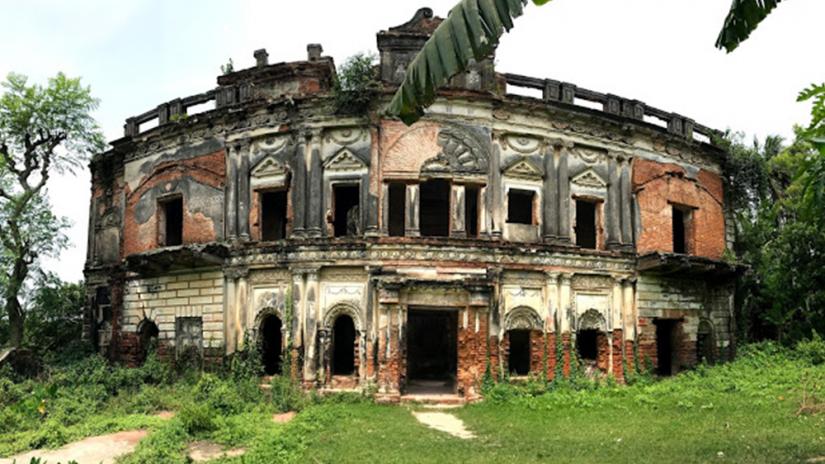
The fertile soil and flood free elevated land made Jhenaidah an ideal destination to live and work. Jhenaidah is home to many notable personalities like mathematician Kalipada Basu, activist Ila Mitra, mystic singer Lalon Shah and freedom fighter Hamidur Rahman.
Traces of human settlements were found in the historical Baro Bazar (twelve bazaars) of Kaliganj upazila in the beginning of the thirteenth century. It was a famous port back then. In the 1860s Indigo Resistance Movement spread all over this zila.
Among the archeological heritage, Miyar Dalan, House of K.P Bashu, Dhol Samudra dighi, Gorar mosque, Golakata dighi and mosque, Peer pukur mosque, Jorbangla mosque, Jahajghata, Noongola mosque, Satgachia mosque are very popular. There is also a large Banyan tree known as the largest Banyan tree of Asia.
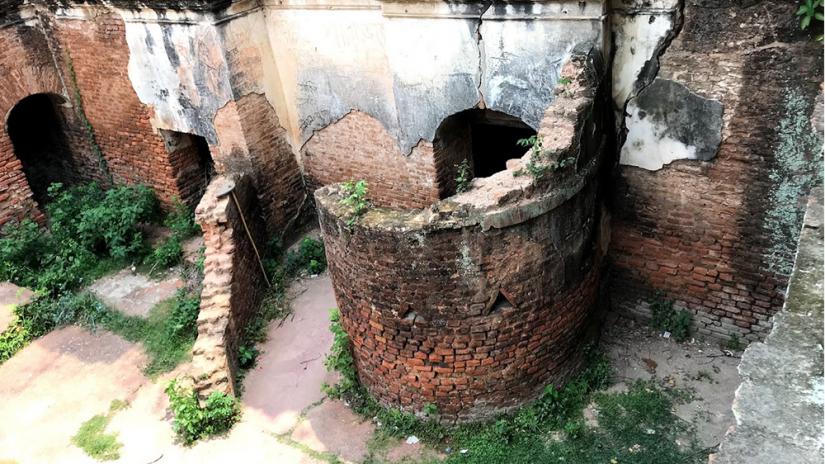 Miyar Dalan
Miyar Dalan
A few miles away from the Arappur bus stand; there is a beautiful ruined palatial building called Miyar Dalan, on the northern side of the river Nabaganga. Although most of the neoclassical decorations are shattered by unauthorized user recklessness, they still bear the decent taste of the owner. The two-story house with numerous rooms is arranged around an inner courtyard, obscured by a circular wall from the entrance. There is a poetic inscription on the main gate of the building which confirms its antiquity. According to the engraved writing, some Raj Chandra of Kolkata started the construction of this building in Bengali year 1229 (1822 AD) and finished in 1236 (1829 AD). It costed about Tk 75,000 to construct the building at that time. During the partition of Bengal, in 1947 the house was sold to someone named Selim Sawdagor (Merchant) and from then it was also known as the ‘House of Selim Sawdagor’. There was a tunnel inside the house that leads to the Nabaganga River. This tunnel is still traceable. Another reason for which the house has become famous that is there was a date palm with multiple heads in the premises of the house.
Dhol (drum) Samudra Dighi
There are many large and small waterbodies in the district of Jhenaidah, but none of them can beat the beauty of Dhol (drum) Samudra Dighi (tank) located at Paglakanai union, only 5 kilometres away from Jhenaidah sadar. Excavated on 52 bighas (21 acres) of land, this dighi is the largest of all the ponds in Jhenaidah. A mighty Zamindar (landlord) called Raja Mukut Roy excavated this huge water body to meet the scarcity of water. It is said that after the excavation of the pond, water came up from the bottom with a strong flow. Seeing this, the people expressed their joy with drums and thus it was known as Dhol (drum) Samudra Dighi. Though the pond is dry at present, the place is a popular tourist destination for surrounded by thousands of trees and plants.
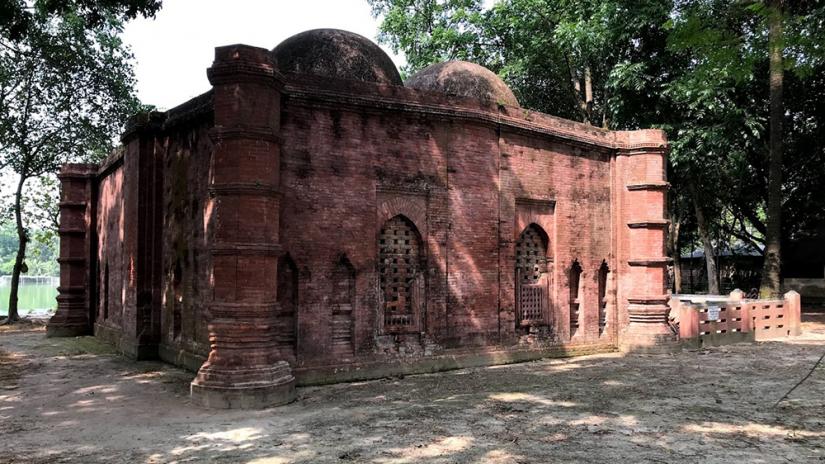 Golakata Mosque
Golakata Mosque
On the southern bank of the water reservoir named Galakata Dighi, there is a six domed mosque known as the same name of the reservoir. The mosque was built on a 37’-7” X 26’-8” rectangular base and possesses two stone pillars with chain and bell motif as a pre Muslim trait. There were three arched openings at the east, three mihrabs at the west and an opening studded with grating on North and South wall. The turrets at each corner were hexagonal shape.
 Jorbangla Mosque
Jorbangla Mosque
The newly restored Jorbangla mosque situated at a distance of 1.25 miles from the Adina mosque close to the Barobazar-Taherpur road in the village of Barobazar. The external dimension of the mosque is 25’-7” X 25’-9’’ externally and it is built on a 177’-4”x 169’-8’’ platform. This single domed structure poses traditional triple-doorways on the east, a blind arch arrangement to the north and south and three semicircular prayer niches to the west. There was also a well decorated mihrab at the centre of the west wall.
Satgachia Mosque
Satgachia mosque is known as the second largest multi-domed mosque in the south with a cluster of 35 domes. The large prayer hall is divided into seven bays and five aisles by a series of heavy pillars, assumed 24 in number. Corresponding to its bays and aisles there were originally seven doorways on the east, six mihrabs to the west and an uncertain numbers of openings to the north and south. The oblong structure is measured about 78’ X 60’ with almost 5 feet thick wall.
Pir Pukur Mosque
The Pir Pukur mosque is the first structure that catches attention on the way from Barobazar Bus stand to Taherpur Road. It is a fifteen domed rectangular-shaped mosque measuring about 62’-3” X 40’-1’’, standing beside a north-south elongated water reservoir called Pir Pukur Dighi. All the domes disappeared and only the walls survived up to certain height. But the eight free standing pillars in the interior and twelve pilasters engaged on the walls indicate the existence of those domes. The mosque has ornate octagonal turrets at its four corners and horizontal bands on the tower at regular intervals.
 Nungola Mosque
Nungola Mosque
About 200m south-east of Pir Pukur mosque there situates the single domed square mosque known as Nungola mosque. There is also a large oblong water tank known as the same name; the Nungola Dighi. The plan shows traces of a prayer chamber, measuring 21’-8” X 22’-3”, 5’-5” thick wall and an octagonal engaged turret at each of its external corner. There is still reminiscent of three openings in the east, an additional opening on north and south, and three semicircular mihrabs in the qibla wall. The mihrabs and the corner turrets are decorated with terracotta relieved with geometrical pattern as chain and bell motifs. There are 18” wide eight numbers of pilasters on the walls, decorated with horizontal bands. Two graves with dressed piece of stone are lying on the south precinct. The mosque was unveiled by the excavation of Department of Archaeology of Bangladesh in 1994 and some ornamental bricks, crockeries, earthen pots, saucers, terracotta beads and toys were recovered.
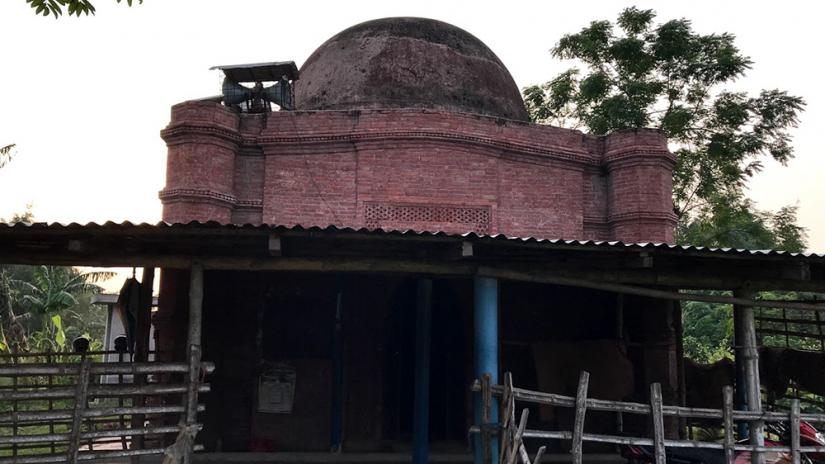 Shukkur Mollick Mosque
Shukkur Mollick Mosque
Few meters west of Nungola mosque another ruined mosque called Sukkur Mollick Mosque was found (approximately 300m south of Barobazar). The mosque is square-shaped and measured 20’ X 20’ externally with 3’-8” thick wall. The dome collapsed but the walls survived upto some heights. It had three mihrabs in the west wall and three doorways in each of the walls except the west. The central mihrab is projected in the exterior side and the other mihrabs on the side were blind. It also had an octagonal corner turret at each of the external corner. The floor of the mosque was really well-built by a single course of bricks with lime terracing at the top. Some ornamental bricks with various types of floral and geometric designs, earthen pots, oil lamps, terracotta balls, beads and toys were found during the excavation as well.
Gorar Mosque
The elegant Gorar mosque is the most popular among the mosques of Barobazar with four domes at two rows; the central prayer hall with a larger hemispherical one and a porch with three smaller domes. The porch has three arched openings that lead to the main prayer hall and they are also aligned to three mihrabs on the west. It is believed to be named after a ‘dorbesh’ (saint) called Gorai. According to some historians Hosen Shah or his son Nusrat Shah built this mosque. Similar mosques like this can be found in other parts of the country; for example Atia mosque in Tangail. Many visitors come here to make a wish, submit sacrificial offerings or donate money.
Monohor Mosque
The Monohor mosque is situated in between Gorar mosque and Golakata mosque, approximately 150m south of another mosque namely, Golakata mosque. This oblong shaped structure measures about 88’-3” in north-south and 63’-8” in east-west direction. There were 24 free standing square brick pillars and it is assumed to be a 35-domed mosque. The multilayered platforms are consisted of as many as four platforms, of them two still survive. Inside the mosque there is a screen that separates the four bays of the corner. Some historian depicts that as a royal gallery or ‘Badshah ka Takht’. There was a room built outside the mosque at the north-west corner which appeared to be a room for Imam. It was also revealed during the excavation in 1994 by the Department of Archeology of Bangladesh.
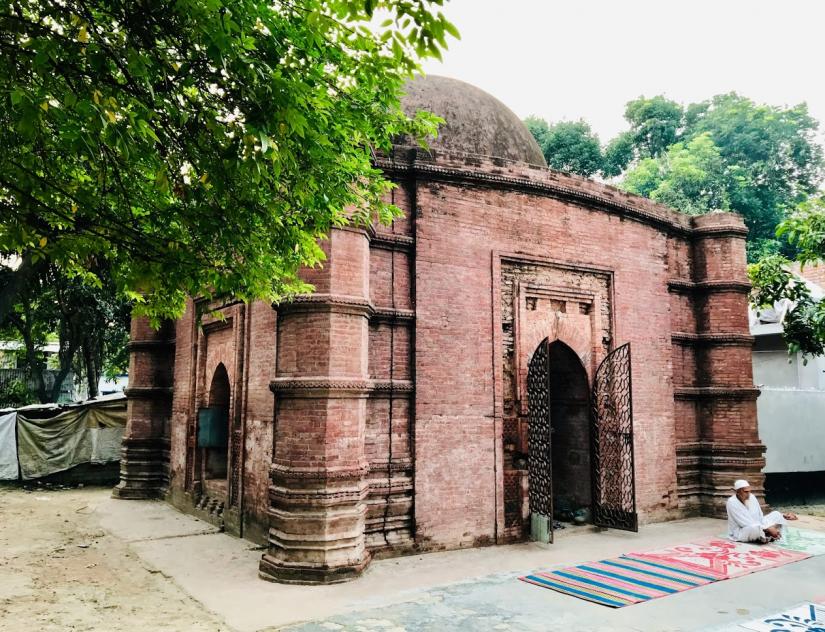 Pathagar Mosque
Pathagar Mosque
A smaller mosque measuring 18’-8”x18’-6” in size is called Pathagar mosque is situated in village Mithapukur. There is still evidence of a doorway in each side of its east, north and south wall and a mihrab on the west. It has a north to south elongated reservoir on its east.
Crafts and other things to explore
Along the roads of Shornokarpotti (old urban settlement of goldsmith community) of the Jhenaidah City, there are different types of souvenir shops selling pottery, hand-embroidered dresses, table cloths and floor mats. Taw bazar, the oldest market of the city is also nearby with separate vegetable market, stationery shops and shops of many essential products.
The Debdaru Avenue (avenue of weeping willow tree) beside Castle Bridge and the Shilpakala Academy is a place of scenic beauty and serenity. Not very far from the avenue, the old Nabaganga river ghat on the confluence of the river a place of offering idols to the river for the Hindus. There used to be a traditional fair or Aarong held during the time of the festival in old days.


